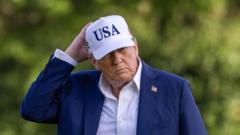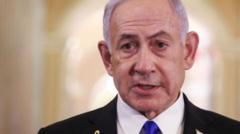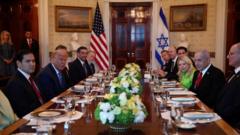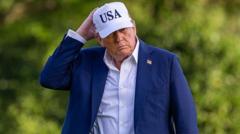In his initiative to impose tariffs, President Trump is encountering mounting resistance from global trading partners and is now extending deadlines—a reflection of stalled negotiations and heightened international tensions.
Trump Postpones Tariffs Amid Global Trade Tension

Trump Postpones Tariffs Amid Global Trade Tension
As nations respond with resistance, Trump's trade plans face significant setbacks.
___
In a surprising move, President Donald Trump has decided to postpone the imposition of tariffs originally scheduled for 9 July, pushing the deadline to 1 August, with the possibility of further delays. Initially promoting a strategy to secure "90 deals in 90 days," the reality suggests that fewer than nine agreements will be reached within this timeframe. Treasury Secretary Scott Bessent has indicated the administration's primary focus is on 18 key nations that contribute to 95% of the U.S. trade deficit.
Recent communications from the White House have been described as a revival of the previously criticized "Liberation Day" message, wherein tariff rates mirror those announced back on 2 April. The administration's claim to fight' trade cheating,' using the size of the deficit as a measure, remains intact. Despite these announcements, the absence of market volatility typically associated with trade war threats is noteworthy. Financial analysts have coined the acronym TACO, suggesting that Trump may frequently retreat from his aggressive trade stances, although this could inadvertently prolong negotiations.
Moreover, Japan and South Korea have been identified as primary targets in the initial letters from the U.S., exacerbating existing tensions regarding their respective trade agreements. Japan’s officials have expressed discontent, with its finance minister even hinting at their ability to leverage their substantial holdings of U.S. debt.
The dynamic of the situation reflects a global economy quick to react, as recent data indicate that while U.S. exports to China have decreased by 9.7%, China’s exports to alternative markets such as the United Kingdom, ASEAN countries, and Africa have surged. This shift in trade patterns underscores the impact of altered international relationships, suggesting that nations are redistributing trade resources away from the U.S.
The effective tariff rate imposed by the U.S. is now roughly 15%, a significant increase compared to the historical average of 2% to 4% over the past four decades. While the U.S. Treasury is witnessing an influx of tariff revenue, market analysts remain cautious about the long-term implications. The current calm in the markets may not last as the geopolitical landscape continues to evolve.
Stay informed about the ongoing developments in Trump’s trade policies with RealTime Wire's dedicated coverage of political and economic news.
In a surprising move, President Donald Trump has decided to postpone the imposition of tariffs originally scheduled for 9 July, pushing the deadline to 1 August, with the possibility of further delays. Initially promoting a strategy to secure "90 deals in 90 days," the reality suggests that fewer than nine agreements will be reached within this timeframe. Treasury Secretary Scott Bessent has indicated the administration's primary focus is on 18 key nations that contribute to 95% of the U.S. trade deficit.
Recent communications from the White House have been described as a revival of the previously criticized "Liberation Day" message, wherein tariff rates mirror those announced back on 2 April. The administration's claim to fight' trade cheating,' using the size of the deficit as a measure, remains intact. Despite these announcements, the absence of market volatility typically associated with trade war threats is noteworthy. Financial analysts have coined the acronym TACO, suggesting that Trump may frequently retreat from his aggressive trade stances, although this could inadvertently prolong negotiations.
Moreover, Japan and South Korea have been identified as primary targets in the initial letters from the U.S., exacerbating existing tensions regarding their respective trade agreements. Japan’s officials have expressed discontent, with its finance minister even hinting at their ability to leverage their substantial holdings of U.S. debt.
The dynamic of the situation reflects a global economy quick to react, as recent data indicate that while U.S. exports to China have decreased by 9.7%, China’s exports to alternative markets such as the United Kingdom, ASEAN countries, and Africa have surged. This shift in trade patterns underscores the impact of altered international relationships, suggesting that nations are redistributing trade resources away from the U.S.
The effective tariff rate imposed by the U.S. is now roughly 15%, a significant increase compared to the historical average of 2% to 4% over the past four decades. While the U.S. Treasury is witnessing an influx of tariff revenue, market analysts remain cautious about the long-term implications. The current calm in the markets may not last as the geopolitical landscape continues to evolve.
Stay informed about the ongoing developments in Trump’s trade policies with RealTime Wire's dedicated coverage of political and economic news.




















